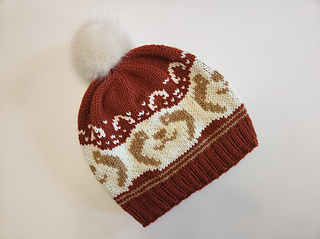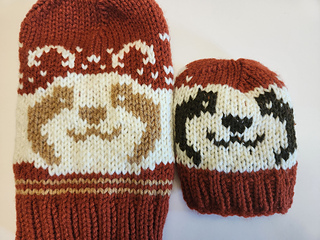Stranded Red Panda (or Raccoon) hat
by Robyn Fiori
patterns >  Robyn Fiori's Ravelry Store
Robyn Fiori's Ravelry Store
> Stranded Red Panda (or Raccoon) hat


© Robyn Fiori

© Robyn Fiori
Stranded Red Panda (or Raccoon) hat
by Robyn Fiori
Materials:
- Soft Classic Solid Yarn Loops & Threads in Clay, White, and Taupe (< 1 skein each)
- Needles #1 4.0 mm (size 6) cable and / or double pointed needles or one size smaller than #2
- Needles #2 4.5 mm (size 7) cable and / or double pointed needles or whatever size is needed for the gauge
- Needles #3 5.0 (size 8) cable and / or double pointed needles or one size larger than #2sed for hat with lining)
- Tapestry Needle
- 4-5 inch pompom
Abbreviations:
K Knit
P Purl
K2tog Knit two together
DPN double pointed needles
Gauge:
Using the #2 size needles: 17 stitches and 24 rows makes a 10 cm (3.9 inch) square. Stranding in this hat requires running the unused yarn behind your work. Make sure to keep these runs relaxed, or the hat will be too tight.
Notes:
- I recommend reading through the entire pattern before you begin.
- This pattern is written in US terms.
- To slightly increase or decrease the size of the hat, adjust the size of your needles.
- The brim of the hat is made with the #1 needles. To make the main part of the hat switch to a larger size. To make a hat WITHOUT using a lining use the #2 needles for the main part of the hat. To make a hat WITH the lining, use the #3 needles for the main part of the hat, and the #2 needles for the lining. Using a liner helps to hide messy runs. Don’t worry if your hat feels a little snug to start, as it relaxes with wear. You can stretch it overnight over a pot if you want it to speed the process.
- Throughout this knit I use a cable needle as it’s easier to keep a good tension over the stranded section this way. At the decrease I switch to 4 DPNs, splitting the stitches evenly between 3 needles and knitting with the fourth.
- Because this pattern is worked in the round, I prefer to work all stitches through the back loop as it’s quicker (for me).
- This is a challenging pattern with lots of long floats. I recommend catching your floats every 2-3 stitches, keeping a relaxed stitch, and checking you work every row to ensure you haven’t pulled it too tight. This is particularly important on the first and last white row, as you’ll be carrying three strands for these rows. Because you’re mostly hiding dark colours behind white. If you’re new to stranded knitting, you may find this easier if you select a white yarn that is slightly thicker than your dark.
About this pattern
About this yarn
by Loops & Threads
Aran
100% Acrylic
354 yards
/
198
grams
4522 projects
stashed
5190 times
rating
of
4.3
from
325 votes
More from Robyn Fiori
Bundles with this pattern
- First published: August 2025
- Page created: August 19, 2025
- Last updated: August 20, 2025 …
- visits in the last 24 hours
- visitors right now





